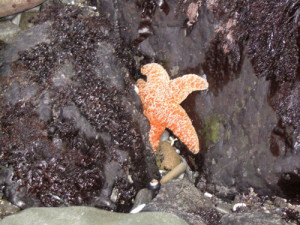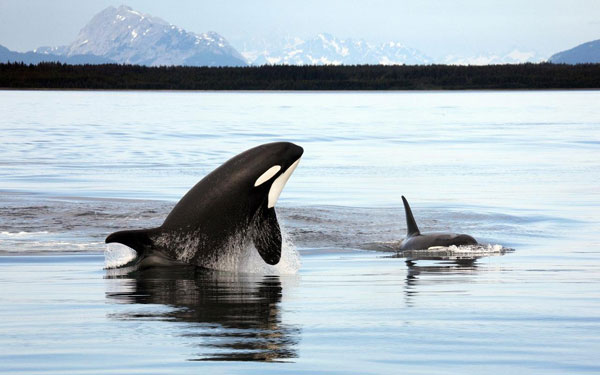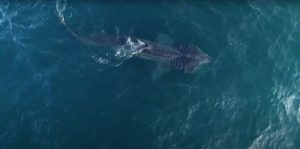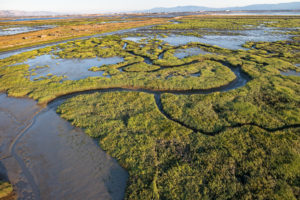National Park Service ecologist Sarah Allen has been looking at the “big picture” of marine ecosystem health since the mid-1970s when she worked as a field biologist on the Farallon Islands, then later in the ’80s and ’90s tracking seabirds, whales, and seals in the Gulf of the Farallones for Point Reyes Bird Observatory (now Point Blue Conservation Science).

After grad school she resumed her work as a marine ecologist, working for the Point Reyes National Seashore. Author of Bay Nature’s current cover story on orcas (Jan-Mar 2014), Sarah now connects the dots for researchers at 24 national marine parks across the Pacific West and represents the National Park Service in inter-agency ocean policy issues. She recently took time out from her very busy job as NPS’ Coast and Ocean Program Lead (Pacific West Region) to talk to Bay Nature.
Are you originally from the Bay Area? Tell us a bit about your educational background.
Yes, I’ve lived here most of my life since age 7. When I was in high school my biology teacher connected me with a professor at the College of Marin to sample bivalves in Bolinas Lagoon. That’s where my interest in field study began. I got my Bachelor of Science in Conservation of Natural Resources at UC Berkeley in 1976, taking classes from Starker Leopold, who at the time was on the Marine Mammal Commission. Later I returned to UC and got my MS and PhD in Wildland Resource Science.
How would you describe your current job to non-scientists?
Generally, my role is to work with national parks and other federal agencies and organizations across the Pacific to protect and restore ocean and coastal habitats and the species that live in them. We’re working to understand how ocean ecosystems function through research and monitoring, and then communicate new discoveries to the public. I assist parks on issues that cut across park boundaries, like marine soundscapes and marine debris. These days my main habitat is a desk with computer and phone. I’m more like a “bureau-ologist” than a field scientist now!
What are some of the issues on your plate at the moment?
Marine debris is one: The parks are monitoring their beaches for debris from the Fukushima nuclear disaster and submitting that data to NOAA (the National Oceanic and Atmospheric Administration), the lead agency on this issue. Another issue is the status of our coral reef parks that extend from Hawaii to Guam. I assist the parks in acquiring the data they need to manage and protect coral reefs, and connect park biologists with scientists who might be able to do the research that expands our understanding of bottom habitats, near-shore currents, and coral recruitment.

Sea star wasting disease is another topic I’m working on; it cuts across parks and agency boundaries, and I’m helping to inform the parks on this emerging issue and provide guidance if they need it to ensure that the right protocols are being used and that the data they collect is shared with other agencies. Scientists are surveying at nine parks along the Pacific coast from Olympic National Park in Washington down to Cabrillo in San Diego. Some parks, such as Olympic and the Channel Islands, have large marine programs with expert staff and are well equipped in this program, but other parks may need assistance.
And then there’s climate change — the largest issue that all parks are facing now. Many parks, for example, are studying the potential effects of sea level rise on coastal resources and developing strategies to respond to potential changes. That is why developing inventories of what exists in parks now is so important, to have as a reference point to compare with what is changing. This month, Golden Gate National Recreation Area is conducting a bio-blitz (March 28-29, 2014) in conjunction with the National Geographic Society to inventory as many species as they can within the park over two days.
You’ve spent quite a bit of your time studying marine mammals and seabirds in the field. Do you still get to do some marine mammal-watching?
I don’t go out in the field like I used to—I work out of an office in San Francisco most of the time. But I also spend time up at Point Reyes monitoring pinnipeds. And when there’s a marine mammal stranding or an unusual sighting on the coast, the stranding network for marine mammals knows to contact me!
Why are killer whales in particular so hard to track?
All cetaceans are difficult to study because they’re among the largest animals on earth, can travel vast distances, dive to extraordinary depths, and communicate in a foreign language (sometimes outside the human range of hearing). So scientists have a difficult time tracking their movements or understanding their social interactions. In the past, we’ve been limited to what can be observed at the ocean’s surface when the whales surface to breath. More recently, scientists have been able to attach small tags to the whales that now provide a window into what they do under water and where they go. There is much, much more, though, to learn about this mysterious marine mammal.
How does citizen science fit in with all the “official” research? Is it considered just as valid as the data scientists collect?

“Citizen science” has been around for a long time. It used to be called volunteering!
Collecting high quality data is fundamental to science, but there are many challenges to collecting good data, including weather, equipment failure and differences between observers. There are relatively few scientists, though, and so citizen scientists (trained volunteers) are the backbone of many science programs because they can collect data more frequently and over a wider area. One way to address these challenges is a tiered approach, with scientists collecting more complex data and volunteers collecting less complex data. Counting sick sea stars is an example. The higher level of data collection tracks a range of species, including sea stars and their sizes, and the rate of sea star infection, while the volunteer data is mainly counting the sea stars and identifying if they are infected. Melissa Minor of UC Santa Cruz has developed the protocol citizen scientists are using to study sea stars. She’s testing it in conjunction with Cal Academy and NOAA to learn how well the data compares with that collected by biologists.
Ocean ecosystems seem to be under a lot of stress right now. How is the average person supposed to handle all the bad news?
We’re hearing a lot of doom and gloom, but the amazing recovery stories are just as important for people to hear. Elephant seals are an example: By setting aside terrestrial breeding habitat for this species, we’ve made it possible for them to make a remarkable recovery. Humpback whales off California have rebounded from the days when they were hunted.
People also need to know they can help ecosystems and species adapt to a changing climate by providing protection and restoring habitats. The best local example I can think of is the restoration of wetlands in San Francisco Bay. Citizens of all ages have volunteered to plant native species and study wildlife in restored marshes.

How do you stay positive and energized?
To prevent myself from going stale in my work I began training high school students to monitor elephant seals a few years ago. It’s nice to see the seals through different eyes. I can’t get in the field as much anymore, but the students give me the chance to do it once in a while. And it’s important to get the next generation engaged.
What can people do if they’re interested in monitoring wildlife in the national parks?
Each national park has a volunteer program. Golden Gate NRA has a large volunteer program and Point Reyes has a program to monitor sea lions and seals, tule elk, rare plants, and snowy plovers. People can also help to restore native habitats. This work simply could not be done without the community’s participation.
You’ve spent a good deal of your life watching wildlife at Point Reyes. What’s your favorite viewing spot there?
The Point Reyes Lighthouse is an extraordinary place. You feel like you’re on a ship out in the ocean, and it juts out so far that you can see species you can’t ordinarily see from land, like blue whales, fin whales, and nesting seabirds – it’s pretty amazing, especially in winter without the fog.
Do you have a favorite spot to watch killer whales?
Being on a boat in Monterey Bay is the best place to see orcas when they’re following gray whales migrating north in the spring. It’s an extraordinary wildlife experience.
Sarah is the primary author of the Field Guide to Marine Mammals of the Pacific Coast (UC Press, 2011).
>> To learn more about the upcoming National Geographic-National Park Service Bioblitz or volunteering at the Golden Gate National Recreation Area, visit the Golden Gate National Parks Conservancy’s website.





